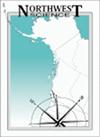Status of Three Large Populations of Western Pearlshell (Bivalvia: Margaritiferidae: Margaritifera falcata) in the Willamette River Basin, Oregon
IF 0.5
4区 环境科学与生态学
Q4 ECOLOGY
引用次数: 0
Abstract
Abstract Freshwater mussels in the western US are under-studied compared to their eastern cousins, and no western species receive federal protection. Mussel distribution throughout Oregon's rivers and streams is poorly documented, and there are limited historical records to inform assessments of whether, and by how much, current populations may have declined. We launched a long-term project to characterize freshwater mussel populations throughout the Willamette River basin. Surveys were conducted in the mainstem Willamette River and a major tributary, the Middle Fork Willamette, during three years. A two-stage sampling process was used; transects were surveyed qualitatively, and then 0.25 m2 quadrats were placed randomly in transects for quantitative surveys. Mussels visible at the substrate surface were counted using viewing scopes and snorkeling, and scuba diving in deeper water. To facilitate detection of juveniles (≤ 3.50 cm long) and calculation of the burial factor, some quadrats were double sampled; mussels visible at the surface were counted, then the substrate was excavated to a depth of 10 to 20 cm, and all mussels (surface and buried) were counted and their shell length measured. Dense western pearlshell (Margaritifera falcata) populations were found at all locations, but they differed greatly in length class structure, density, and presence of juveniles. Some sites also contained small numbers of floaters (Anodonta spp.), and notably, a single western ridgemussel (Gonidea angulata) was found in a highly urbanized reach. These surveys provide baseline data on the current status of several freshwater mussel populations in the Willamette River basin.俄勒冈州威拉米特河流域西部珍珠贝(双壳亚目:珍珠贝科:珍珠贝科:falcata)三个大种群的现状
摘要与东部同类相比,美国西部的淡水贻贝研究不足,没有任何西部物种受到联邦保护。俄勒冈州河流和溪流中的贻贝分布情况记录不足,评估当前种群数量是否下降以及下降幅度的历史记录也有限。我们启动了一个长期项目,以确定整个威拉米特河流域淡水贻贝种群的特征。在三年的时间里,对威拉米特河干流和一条主要支流中福克威拉米特进行了调查。采用了两阶段取样过程;对样带进行定性调查,然后在样带中随机放置0.25m2的象限进行定量调查。通过观察镜、浮潜和在深水中潜水,对基底表面可见的贻贝进行了计数。为了便于检测幼体(≤3.50厘米长)和计算埋葬因子,对一些象限进行了双重采样;对表面可见的贻贝进行计数,然后将基质挖掘至10至20厘米的深度,对所有贻贝(表面和埋藏)进行计数,并测量其外壳长度。在所有地点都发现了密集的西方珍珠壳(Margaritifera falcata)种群,但它们在长度、等级结构、密度和幼鱼数量方面差异很大。一些地点也有少量的浮游动物(Anodonta spp.),值得注意的是,在高度城市化的河段发现了一只西部脊贻贝(Gonidea angulata)。这些调查提供了威拉米特河流域几种淡水贻贝种群现状的基线数据。
本文章由计算机程序翻译,如有差异,请以英文原文为准。
求助全文
约1分钟内获得全文
求助全文
来源期刊

Northwest Science
环境科学-生态学
CiteScore
1.30
自引率
0.00%
发文量
23
审稿时长
>36 weeks
期刊介绍:
The pages of Northwest Science are open to original and fundamental research in the basic, applied, and social sciences. All submissions are refereed by at least two qualified peer reviewers. Papers are welcome from authors outside of the Pacific Northwest if the topic is suitable to our regional audience.
 求助内容:
求助内容: 应助结果提醒方式:
应助结果提醒方式:


